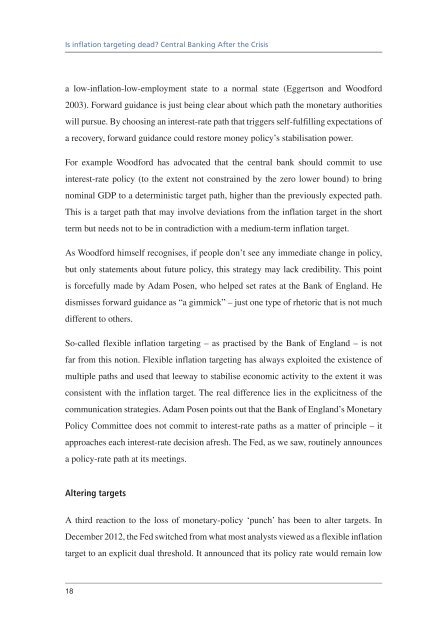Is inflation targeting dead? Central Banking After the Crisis - Vox
Is inflation targeting dead? Central Banking After the Crisis - Vox
Is inflation targeting dead? Central Banking After the Crisis - Vox
You also want an ePaper? Increase the reach of your titles
YUMPU automatically turns print PDFs into web optimized ePapers that Google loves.
<strong>Is</strong> <strong>inflation</strong> <strong>targeting</strong> <strong>dead</strong>? <strong>Central</strong> <strong>Banking</strong> <strong>After</strong> <strong>the</strong> <strong>Crisis</strong>a low-<strong>inflation</strong>-low-employment state to a normal state (Eggertson and Woodford2003). Forward guidance is just being clear about which path <strong>the</strong> monetary authoritieswill pursue. By choosing an interest-rate path that triggers self-fulfilling expectations ofa recovery, forward guidance could restore money policy’s stabilisation power.For example Woodford has advocated that <strong>the</strong> central bank should commit to useinterest-rate policy (to <strong>the</strong> extent not constrained by <strong>the</strong> zero lower bound) to bringnominal GDP to a deterministic target path, higher than <strong>the</strong> previously expected path.This is a target path that may involve deviations from <strong>the</strong> <strong>inflation</strong> target in <strong>the</strong> shortterm but needs not to be in contradiction with a medium-term <strong>inflation</strong> target.As Woodford himself recognises, if people don’t see any immediate change in policy,but only statements about future policy, this strategy may lack credibility. This pointis forcefully made by Adam Posen, who helped set rates at <strong>the</strong> Bank of England. Hedismisses forward guidance as “a gimmick” – just one type of rhetoric that is not muchdifferent to o<strong>the</strong>rs.So-called flexible <strong>inflation</strong> <strong>targeting</strong> – as practised by <strong>the</strong> Bank of England – is notfar from this notion. Flexible <strong>inflation</strong> <strong>targeting</strong> has always exploited <strong>the</strong> existence ofmultiple paths and used that leeway to stabilise economic activity to <strong>the</strong> extent it wasconsistent with <strong>the</strong> <strong>inflation</strong> target. The real difference lies in <strong>the</strong> explicitness of <strong>the</strong>communication strategies. Adam Posen points out that <strong>the</strong> Bank of England’s MonetaryPolicy Committee does not commit to interest-rate paths as a matter of principle – itapproaches each interest-rate decision afresh. The Fed, as we saw, routinely announcesa policy-rate path at its meetings.Altering targetsA third reaction to <strong>the</strong> loss of monetary-policy ‘punch’ has been to alter targets. InDecember 2012, <strong>the</strong> Fed switched from what most analysts viewed as a flexible <strong>inflation</strong>target to an explicit dual threshold. It announced that its policy rate would remain low18














